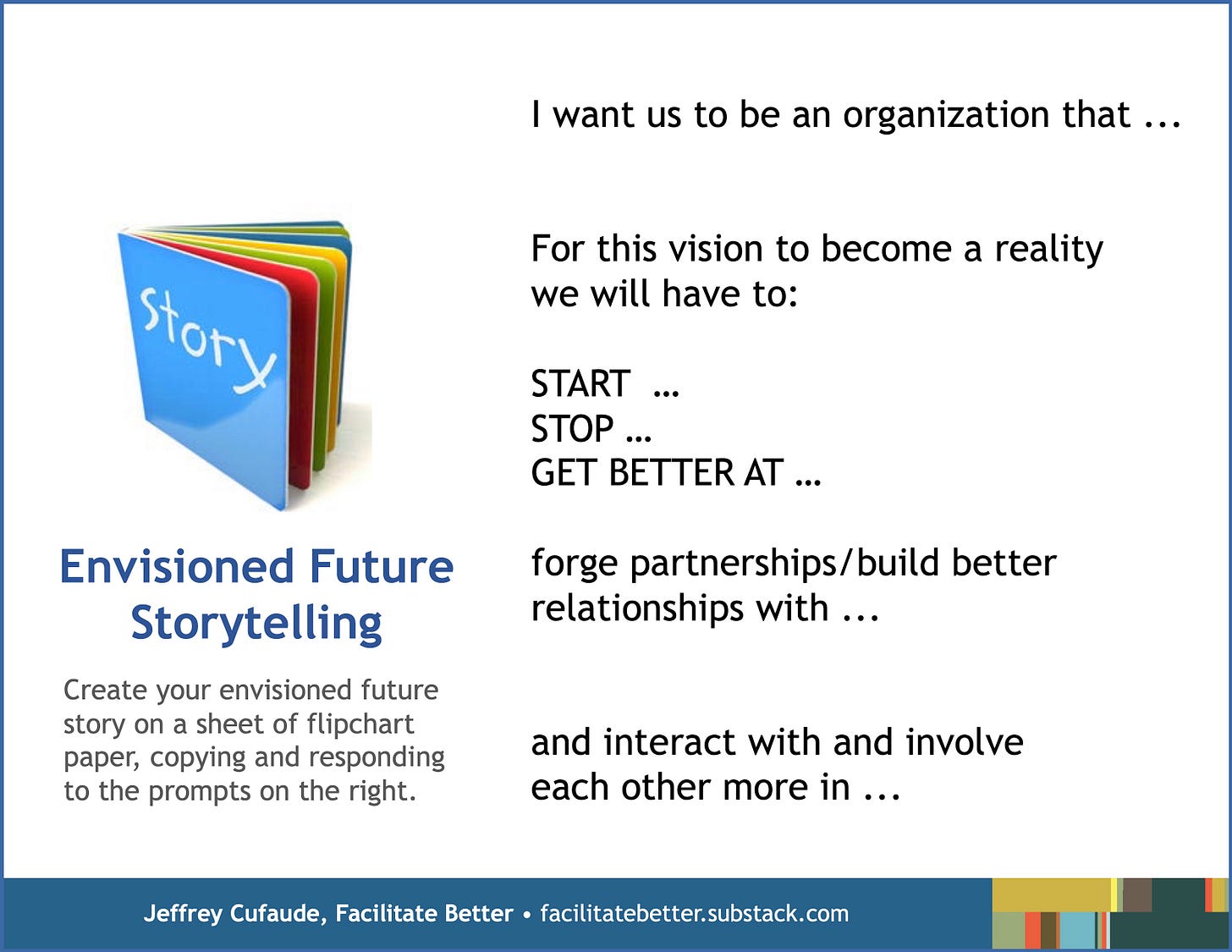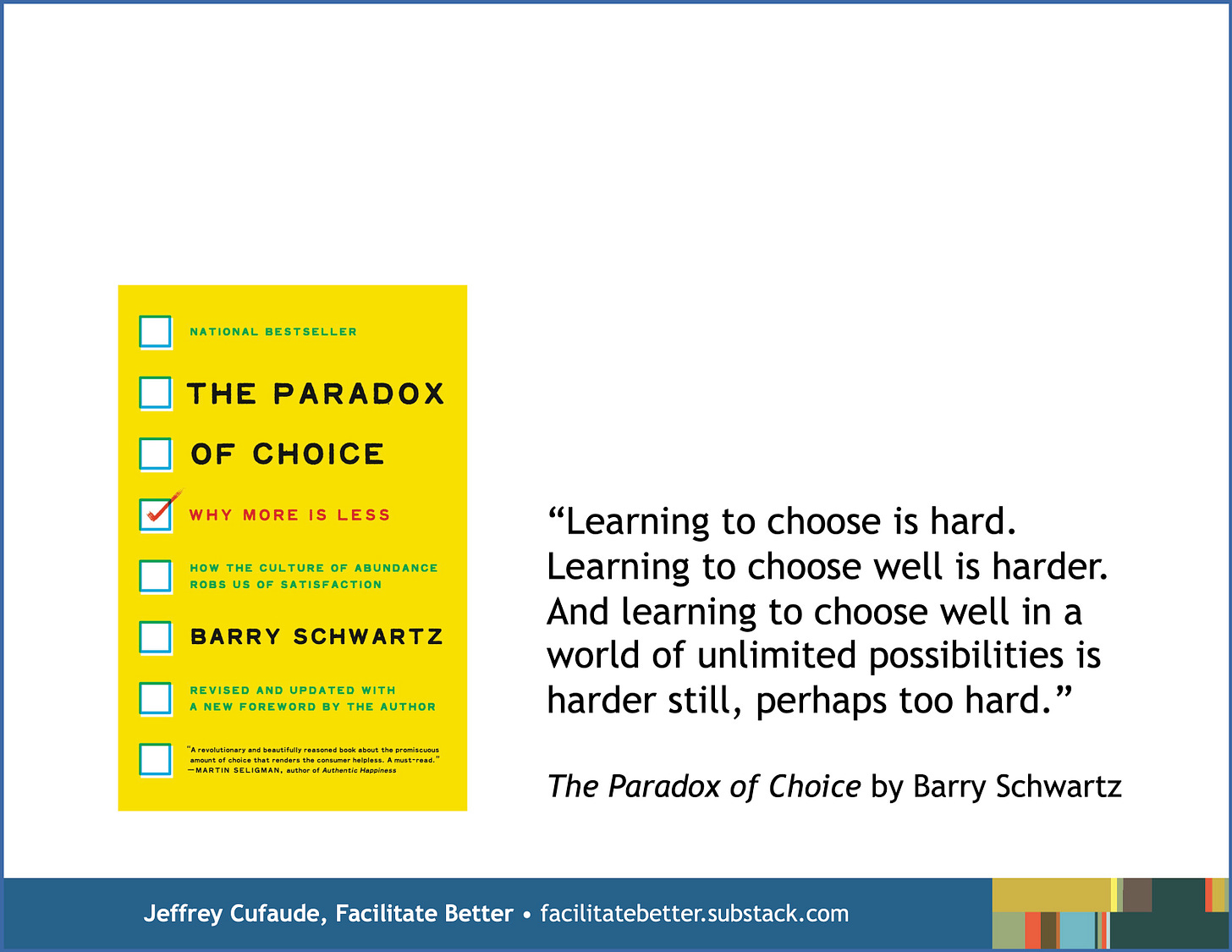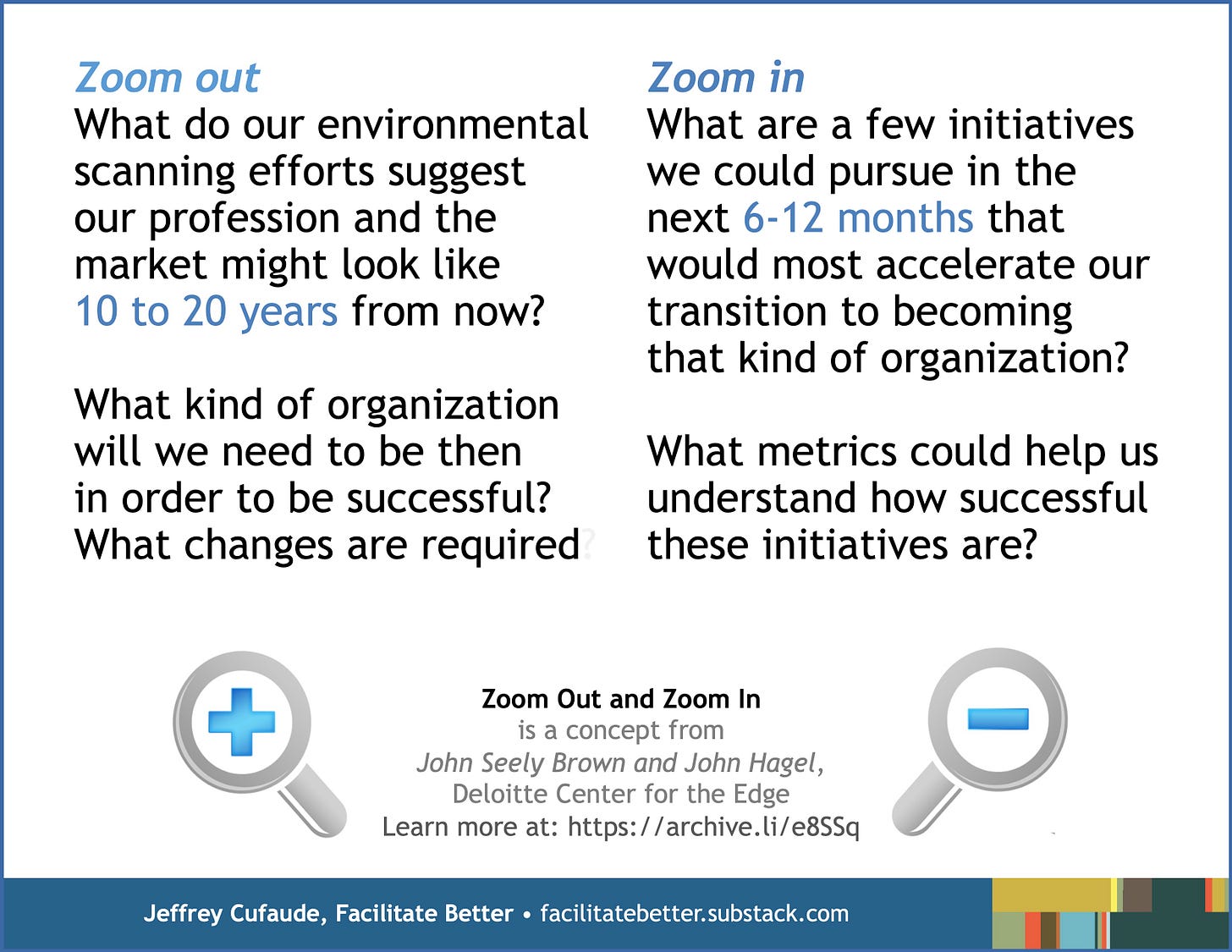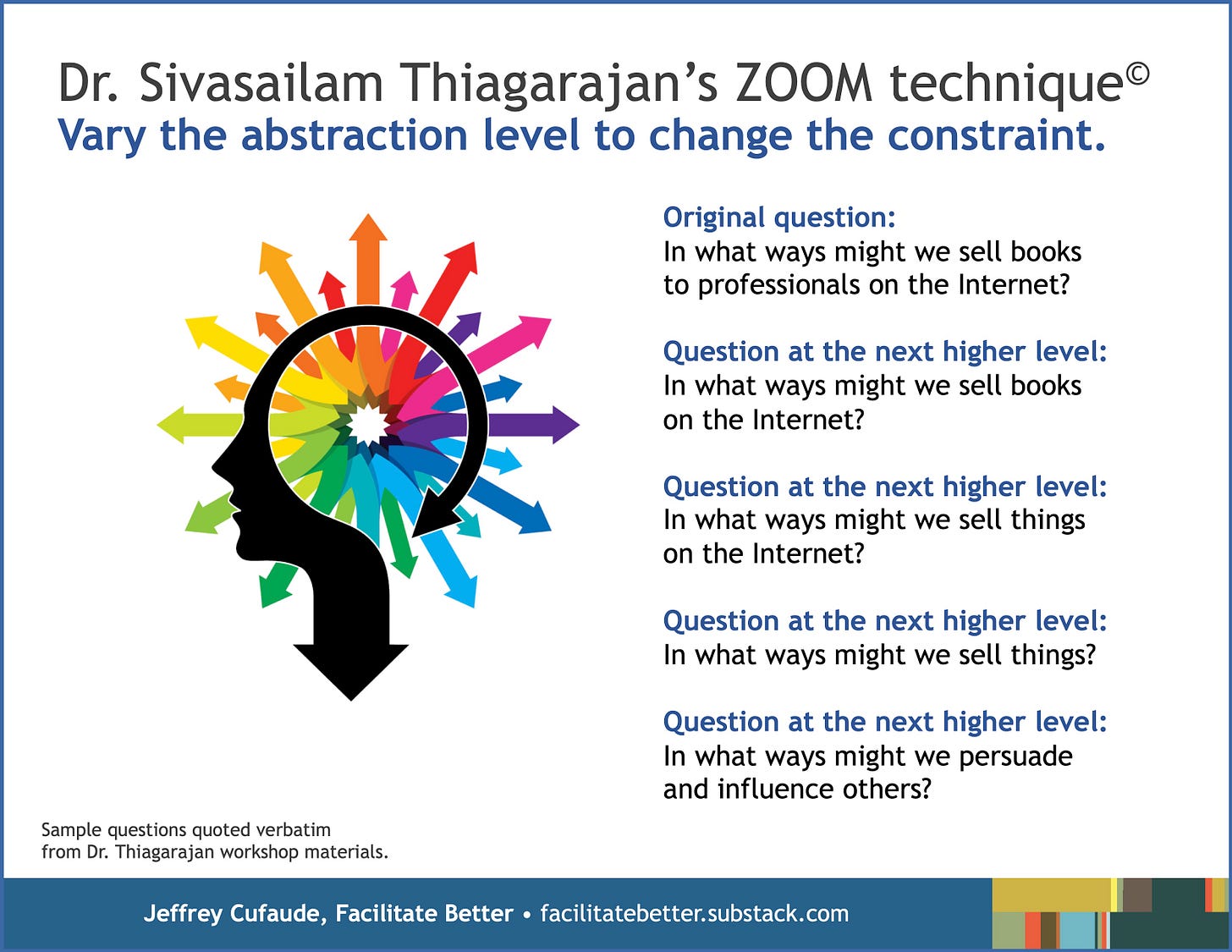Leverage Diverse Constraints to Promote More Innovative Results (Facilitation Friday #81)
Constraints often make it easier, not harder, to generate more interesting and innovative ideas.
Would you believe that restricting participants’ thinking is one of the fastest ways to make it easier for them to generate innovative ideas?
Say what?
While it may be counter-intuitive, introducing constraints, rather than allowing for open-ended thinking, often yields more innovation. Here’s why according to three researchers who reviewed more than 145 empirical studies for a Harvard Business Review article entitled, “Why Constraints Are Good for Innovation.”
“According to the studies we reviewed, when there are no constraints on the creative process, complacency sets in, and people follow what psychologists call the path-of-least-resistance – they go for the most intuitive idea that comes to mind rather than investing in the development of better ideas. Constraints, in contrast, provide focus and a creative challenge that motivates people to search for and connect information from different sources to generate novel ideas for new products, services, or business processes” (Harvard Business Review, November 22, 2019).
It makes sense when you think about it. Imagine you sit down to write a Substack post like this one. The flashing cursor and your blank screen might torture you with their openness. But start with a draft title or even the HBR quote referenced and you now have a focal point to build upon.
It is why during visioning or strategic planning sessions, I’m less likely to simply ask participants to share a story about an ideal future for their organization. Instead, I ask them to draft a story responding to a handful of prompts I provide like the ones below. These modest constraints make it easier to more quickly get quality (and often, more interesting) responses.
The same is true when generating ideas or figuring out potential solutions to a problem.
Leveraging constraints in facilitation
Leveraging constraints is similar to how specifying the Job To Be Done can increase idea quantity and quality. Each provides some nominally restrictive guardrails that focus participants’ thinking in a productive manner. This helps prevent the cognitive fatigue from having too many options, something explored in Barry Schwartz’s book, The Paradox of Choice (short summary here).
Imagine you will be facilitating a professional association membership committee meeting convened to answer this question: How might we increase our membership by at least 10% in the next 12 months?
The broad open-ended nature of this question is not an unusual charge to a committee. But to produce a wealth of new and different possibilities, adding some constraints to focus and inspire committee members’ thinking is desirable.
Basic constraints
Almost any member demographic is a potentially useful basic constraint, including: age, years in profession, geographic location, professional interest areas, career stage, job title/functional role, size of organization, primary reason for joining, membership category/classification.
Simply add the constraint to the original question and have participants start sharing ideas using one of the formats described later.
Constrained question example: How might we increase membership among international members by 10% in the next 12 months?
My hunch is these basic constraints might help increase the quantity and quality of ideas somewhat, but not necessarily unleash much innovative thinking.
More challenging constraints
I brainstormed 10 more challenging constraints for membership recruitment efforts, ones intended to provoke more interesting and less predictable ideas.
Include at least one dozen testimonials
Be done collaboratively with one or more other associations
Limit costs to no more than $1/new member acquisition
Involve a quiz or game related to the association or profession
Provide limited access to one or more key benefits for a very short time period
Use only personalized handwritten invitations to join
Use only audio or video appeals
Use only direct mail promotional materials
Leverage a volunteer opportunity to entice interest
Make the case to join in a data-rich infographic
Constrained question example: How might we increase membership by 10% in the next 12 months using only personalized handwritten invitations to join?
Identifying “right answers” is not the initial goal when applying constraints to generate ideas; rather, the desired outcome is to generate the maximum number of interesting possibilities for further exploration or refinement. It is not unusual that the final ideas adopted are an amalgam of several possibilities generated.
Using constraints in different formats
Some research has demonstrated that more ideas are generated if participants have time to think on their own before verbalizing them. This individual “think-write-speak” approach also is more inclusive of more introverted thinkers who often are marginalized by the “shout out your ideas” approach of traditional brainstorming sessions.
Individual reflection and idea generation can be used as part of any of the following facilitation formats, even if it is not specified:
Provide participants the list of constraints and let them first individually note their own ideas on index cards. Follow this with one of these interactive group formats:
Have participants place their index cards in large envelopes labeled for each constraint. Then divide them into small groups to sift through and generate additional ideas for their constraint(s).
Facilitate a large group idea brainstorming session that works through all of the constraints, inviting participants to share what they have already noted and then building on those contributions to generate more ideas.Divide participants into small groups and assign each to generate ideas for one or more constraints.
Announce the constraints and let participants form small groups based on the constraint(s) for which they wish to generate ideas.
Use the 6-3-5 format from the linked research article above (also below in PDF form) in which individuals build on the ideas of others in a round-robin read and respond.
To expand the mix of people contributing ideas, consider conducting an online open call for ideas for multiple constraints. Add these submissions to any of the previously mentioned formats.
Any of these creative thinking formats can be followed by a critical thinking round if appropriate, having participants evaluate the ideas generated using predetermined criteria or decision-making rules.
Two additional approaches
Here are two more approaches I find adapt easily and endlessly for use in meetings and workshops. Don’t let the sample questions displayed dissuade you from experimenting with the techniques. You can easily swap in the questions or topics most relevant to your efforts.
Coincidentally, they both use Zoom in their name, shifting time horizons or levels of abstraction or specificity to provide focus, constrain thinking, and promote more innovative idea generation.
Zoom Out and Zoom In (shift/constrain the time horizon)
John Hagel and John Seely Brown’s Zooming Out and In (learn more in this article) is a two-step process helps broaden people’s thinking before connecting them to narrower tactical level application. To illustrate the approach, I provided sample questions of how I use it to launch strategy conversations.
ZOOM (shift/constrain the abstraction level)
Dr. Sivasailam Thiagarajan’s (Thiagi) ZOOM technique© rests on a simple concept: to generate more possibilities, increase the abstraction of a question, essentially varying the constraint.
The additional insights gained from broadening the question can then be discussed and applied in a narrowing fashion, moving back toward the original question posed. Doing so usually generates more innovative responses to this original question, ones informed by exploring the increasingly abstract variations.
Bottom Line?
Open-ended brainstorming or problem solving often yields a healthy number of fairly predictable ideas. Introducing relevant constraints to restrain participants’ thinking and idea generation is proven to yield more innovative results. Effective facilitation thoughtfully does so to frame topics and questions in a more productive manner.
Getting in Action
Experiment with the membership example offered. Select a constraint and spend 2-3 minutes generating ideas. Repeat this process a few times. Reflect on your experience and how different constraints influenced your idea generation.
Identify a topic or question commonly explored in your organization. Determine 5-7 meaningful constraints you could add to provoke more inspired or innovative thinking.
Imagine you are facilitating a meeting and need to introduce the value of constraints and reducing the paradox of choice to participants. What analogy or story would you use to do so?
© Facilitate Better and Jeffrey Cufaude. All rights reserved.
To affordably license this content for reprint on your site or in electronic or print communications or to contact me regarding customized facilitation skills workshops or consultations, complete this form.






